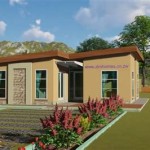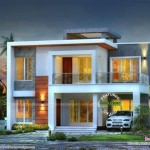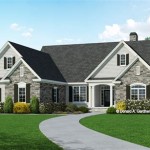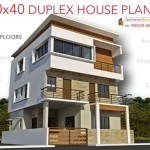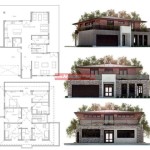1-Story Contemporary House Plans: A Comprehensive Guide
Single-story contemporary house plans have gained significant popularity for their accessibility, modern aesthetics, and adaptability to various lifestyles. These designs prioritize open living spaces, natural light, and seamless integration with the surrounding environment. Understanding the nuances of 1-story contemporary house plans is crucial for prospective homeowners seeking to build a functional, stylish, and comfortable residence.
Contemporary architecture, in the context of residential design, reflects current trends and preferences, often incorporating elements of minimalism, sustainability, and technological innovation. Unlike modern architecture, which adheres to a more defined historical period, contemporary designs are constantly evolving and adapting to new materials, construction techniques, and societal needs. 1-story contemporary house plans, therefore, embody this fluidity and offer a diverse range of options for homeowners.
This article aims to provide a detailed overview of 1-story contemporary house plans, exploring their key characteristics, benefits, design considerations, and cost implications. Understanding these aspects will empower individuals to make informed decisions when selecting a plan that aligns with their specific requirements and preferences.
Key Characteristics of 1-Story Contemporary House Plans
1-story contemporary house plans are defined by several distinct characteristics that differentiate them from other architectural styles. These features contribute to their overall appeal and functionality, making them a sought-after choice for many homeowners.
Open Floor Plans: A hallmark of contemporary design is the emphasis on open floor plans. These layouts minimize interior walls, creating a sense of spaciousness and promoting seamless flow between living areas, kitchens, and dining spaces. This design facilitates social interaction and allows for flexible use of space. Open floor plans are particularly well-suited for entertaining guests and accommodating large gatherings. The absence of physical barriers also enhances natural light penetration, contributing to a brighter and more inviting interior environment. Strategically placed furniture and architectural elements, such as partial walls or changes in floor level, can be used to define distinct zones within the open space without compromising the overall sense of openness.
Large Windows and Natural Light: Maximizing natural light is a crucial aspect of 1-story contemporary house plans. Large windows, often floor-to-ceiling, are strategically positioned to capture sunlight and provide panoramic views of the surrounding landscape. This abundance of natural light reduces the need for artificial illumination during the day, contributing to energy efficiency and creating a more vibrant and welcoming atmosphere. Skylights and strategically placed clerestory windows can further enhance natural light penetration, particularly in areas that may not have direct access to exterior walls. The orientation of the house is also carefully considered to optimize solar gain in winter and minimize heat gain in summer, further contributing to energy savings.
Clean Lines and Minimalist Aesthetic: Contemporary design embraces clean lines, simple geometric shapes, and a minimalist aesthetic. Ornamentation is typically kept to a minimum, with an emphasis on functionality and understated elegance. This approach creates a visually uncluttered and calming environment. Flat or slightly sloping roofs are common, further contributing to the clean and modern appearance. The use of durable and low-maintenance materials, such as concrete, steel, and glass, also aligns with the minimalist principles of contemporary design. Color palettes are often neutral, with accents of bolder colors used sparingly to add visual interest. The focus is on creating a harmonious and balanced composition that emphasizes form and function.
Integration with the Outdoors: Contemporary house plans often feature seamless integration between indoor and outdoor spaces. This is achieved through the use of large sliding glass doors, patios, decks, and outdoor living areas that extend the living space beyond the confines of the interior walls. This connection with nature enhances the overall living experience and promotes a sense of well-being. Outdoor features such as covered patios, outdoor kitchens, and fire pits can further enhance the functionality and enjoyment of the outdoor space. Landscaping is also carefully considered to complement the architecture of the house and create a harmonious transition between the built environment and the natural surroundings.
Benefits of Choosing a 1-Story Contemporary House Plan
Opting for a 1-story contemporary house plan offers several advantages over multi-story designs, particularly for individuals with mobility concerns, those seeking to age in place, or families with young children.
Accessibility and Aging in Place: A primary benefit of a 1-story house is its accessibility. The absence of stairs eliminates a significant barrier for individuals with mobility limitations, making it an ideal choice for those planning to age in place. This design allows for easier navigation throughout the house, reducing the risk of falls and promoting independent living. Universal design principles, such as wider doorways, grab bars in bathrooms, and lever door handles, can be incorporated to further enhance accessibility. This design also simplifies maintenance and cleaning, as all areas of the house are easily reachable.
Simplified Construction and Maintenance: 1-story houses are generally easier and less expensive to construct than multi-story homes. The simplified structural design reduces the need for complex framing and foundation work, resulting in lower construction costs and a shorter construction timeline. Maintenance is also simplified, as accessing the roof, gutters, and exterior walls is easier and safer. This can translate to significant savings in the long run, as maintenance costs are typically lower.
Improved Energy Efficiency: 1-story houses often exhibit improved energy efficiency compared to multi-story homes. Heat rises, and in a multi-story house, this can lead to uneven temperature distribution, with warmer temperatures on the upper floors. In a 1-story house, the temperature is more consistent throughout, reducing the need for excessive heating or cooling. The compact design also minimizes exterior wall surface area, reducing heat loss in winter and heat gain in summer. The strategic placement of windows and overhangs can further enhance energy efficiency by maximizing solar gain in winter and minimizing heat gain in summer.
Enhanced Safety and Security: A 1-story house offers enhanced safety and security. All living areas are located on the ground floor, providing easier access to exits in case of emergency. This is particularly beneficial for families with young children or individuals with mobility limitations. The absence of stairs also eliminates the risk of falls. Security is also enhanced, as all windows and doors are easily accessible for monitoring and securing. This can provide peace of mind, especially for those living in areas with higher crime rates.
Design Considerations for 1-Story Contemporary House Plans
Careful planning and consideration are essential when designing a 1-story contemporary house to ensure that it meets the specific needs and preferences of the homeowner. Several factors should be taken into account, including site conditions, budget constraints, and lifestyle requirements.
Site Orientation and Landscaping: The orientation of the house on the site is crucial for maximizing energy efficiency and optimizing natural light. Ideally, the house should be oriented to take advantage of solar gain in winter and minimize heat gain in summer. Landscaping can also play a significant role in enhancing energy efficiency by providing shade in summer and blocking cold winds in winter. The placement of trees and shrubs can also create a more private and aesthetically pleasing outdoor environment. Careful consideration should be given to the existing topography and vegetation to minimize site disturbance and preserve the natural beauty of the landscape.
Room Layout and Functionality: The layout of the rooms should be carefully considered to ensure that the house is functional and meets the specific needs of the homeowner. The relationship between different living areas should be carefully planned to promote seamless flow and maximize the use of space. The kitchen should be designed to be efficient and functional, with ample counter space and storage. Bedrooms should be located away from high-traffic areas to ensure privacy and quiet. The location of bathrooms should be convenient and accessible. The overall layout should be designed to be flexible and adaptable to changing needs over time.
Material Selection and Sustainability: The selection of materials should be based on durability, aesthetics, and sustainability. Sustainable materials, such as reclaimed wood, recycled content materials, and low-VOC paints, can help to reduce the environmental impact of the house. Durable materials, such as concrete, steel, and brick, can help to ensure that the house will last for many years with minimal maintenance. The aesthetic qualities of the materials should also be considered to ensure that they complement the overall design of the house. The use of natural materials, such as wood and stone, can help to create a warm and inviting atmosphere. The choice of roofing materials should also be carefully considered to ensure that they are durable, energy-efficient, and aesthetically pleasing.
Budget and Cost Considerations: The budget is a critical factor in determining the size, design, and materials used in the house. It is important to establish a realistic budget early in the planning process and to stick to it as closely as possible. Cost-saving measures, such as simplifying the design, using standard materials, and minimizing custom features, can help to keep the project within budget. It is also important to factor in the cost of landscaping, permits, and other miscellaneous expenses. Working with an experienced architect and builder can help to ensure that the project is completed on time and within budget.
In summary, 1-story contemporary house plans offer a compelling combination of accessibility, modern aesthetics, and functional design. By carefully considering the key characteristics, benefits, and design considerations outlined above, prospective homeowners can create a residence that perfectly suits their lifestyle and enhances their quality of life.

Single Story Modern House Plans Designs 87651 Contemporary Design Facade Exterior

1 Story Modern Prairie House Plan Elk Park Porch Plans South Family

Contemporary House Plan 1 Story Coastal Floor

Small One Story 2 Bedroom Retirement House Plans Houseplans Blog Com

1 Story Contemporary Ranch House Plans With 2 Bedrooms

Modern House Design 25x30 M 3 Beds One Story Plan 3d

1 Story House Plans One Modern Luxury Home Floor

Modern House Plan Single Story Open Concept Home 3 Bedroom 2 5 Bathroom With Free Original Cad File Metric Imperial Units

Modern One Story House Plot 20x17 Meter With 2 Beds Pro Home Decors

Contemporary Style House Plan 3 Beds 2 Baths 1131 Sq Ft 923 166 Houseplans Com


